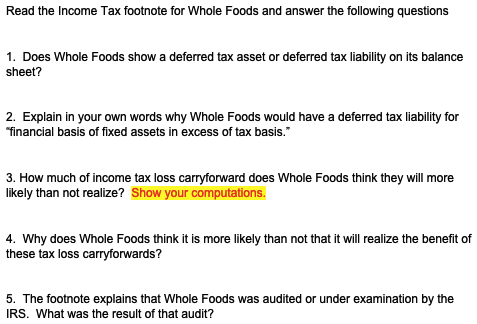
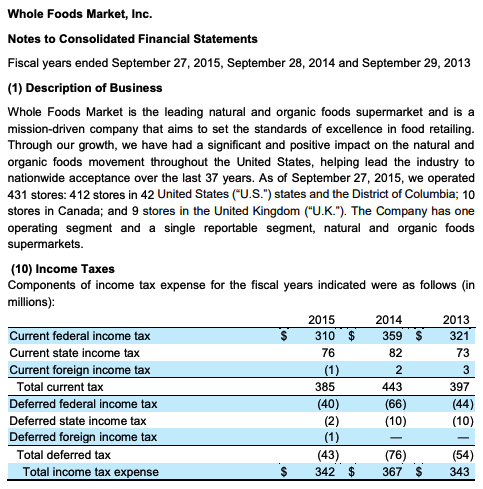
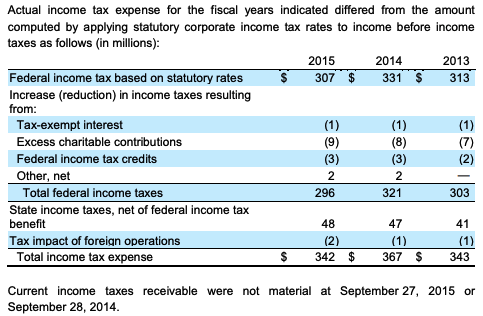
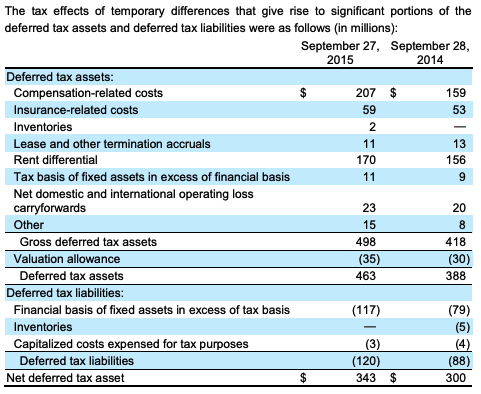
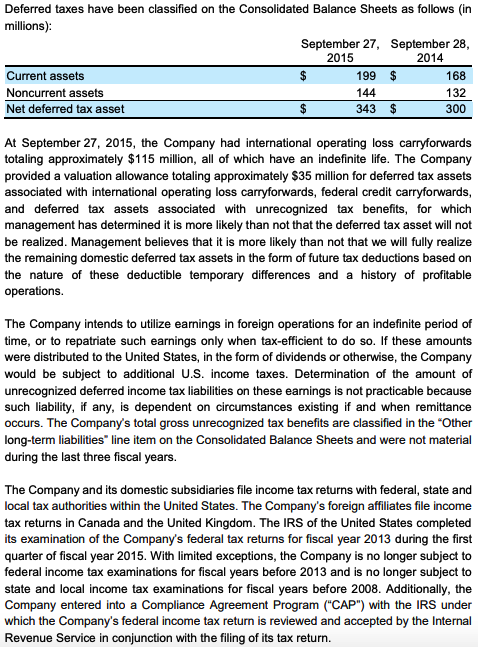
Read the Income Tax footnote for Whole Foods and answer the following questions 1. Does Whole Foods show a deferred tax asset or deferred tax liability on its balance sheet? 2. Explain in your own words why Whole Foods would have a deferred tax liability for "financial basis of fixed assets in excess of tax basis." 3. How much of income tax loss carryforward does Whole Foods think they will more likely than not realize? Show your computations. 4. Why does Whole Foods think it is more likely than not that it will realize the benefit of these tax loss carryforwards? 5. The footnote explains that Whole Foods was audited or under examination by the IRS. What was the result of that audit? Whole Foods Market, Inc. Notes to Consolidated Financial Statements Fiscal years ended September 27, 2015, September 28, 2014 and September 29, 2013 (1) Description of Business Whole Foods Market is the leading natural and organic foods supermarket and is a mission-driven company that aims to set the standards of excellence in food retailing. Through our growth, we have had a significant and positive impact on the natural and organic foods movement throughout the United States, helping lead the industry to nationwide acceptance over the last 37 years. As of September 27, 2015, we operated 431 stores: 412 stores in 42 United States (U.S.") states and the District of Columbia; 10 stores in Canada, and 9 stores in the United Kingdom ("U.K."). The Company has one operating segment and a single reportable segment, natural and organic foods supermarkets. 73 (10) Income Taxes Components of income tax expense for the fiscal years indicated were as follows (in millions): 2015 2014 2013 Current federal income tax $ 310 $ 359$ 321 Current state income tax 76 82 Current foreign income tax (1) 2 Total current tax 385 Deferred federal income tax (40) Deferred state income tax (2) (10) Deferred foreign income tax (1) Total deferred tax (43) (76) Total income tax expense $ 342 $ 367 $ 343 443 (54) Actual income tax expense for the fiscal years indicated differed from the amount computed by applying statutory corporate income tax rates to income before income taxes as follows (in millions): 2015 2014 2013 Federal income tax based on statutory rates $ 307 $ 3315 313 Increase (reduction) in income taxes resulting from: Tax-exempt interest (1) (1) (1) Excess charitable contributions (9) Federal income tax credits Other, net Total federal income taxes 296 321 303 State income taxes, net of federal income tax benefit 48 47 41 Tax impact of foreign operations (2) (1) (1) Total income tax expense $ 342 $ 367 $ 343 (8) (3) (3) Current income taxes receivable were not material at September 27, 2015 or September 28, 2014. 59 11 The tax effects of temporary differences that give rise to significant portions of the deferred tax assets and deferred tax liabilities were as follows (in millions): September 27, September 28, 2015 2014 Deferred tax assets: Compensation-related costs 207 $ 159 Insurance-related costs Inventories 2 Lease and other termination accruals 11 13 Rent differential 170 156 Tax basis of fixed assets in excess of financial basis Net domestic and international operating loss carryforwards 20 Other 15 Gross deferred tax assets 498 418 Valuation allowance (35) (30) Deferred tax assets 463 388 Deferred tax liabilities: Financial basis of fixed assets in excess of tax basis (117) (79) Inventories (5) Capitalized costs expensed for tax purposes (3) Deferred tax liabilities (120) (88) Net deferred tax asset $ 343 $ 300 23 Deferred taxes have been classified on the Consolidated Balance Sheets as follows (in millions): September 27, September 28, 2015 2014 Current assets $ 199 $ 168 Noncurrent assets 144 132 Net deferred tax asset $ 343 $ 300 At September 27, 2015, the Company had international operating loss carryforwards totaling approximately $115 million, all of which have an indefinite life. The Company provided a valuation allowance totaling approximately $35 million for deferred tax assets associated with international operating loss carryforwards, federal credit carryforwards, and deferred tax assets associated with unrecognized tax benefits, for which management has determined it is more likely than not that the deferred tax asset will not be realized. Management believes that it is more likely than not that we will fully realize the remaining domestic deferred tax assets in the form of future tax deductions based on the nature of these deductible temporary differences and a history of profitable operations. The Company intends to utilize earnings in foreign operations for an indefinite period of time, or to repatriate such earnings only when tax-efficient to do so. If these amounts were distributed to the United States, in the form of dividends or otherwise, the Company would be subject to additional U.S. income taxes. Determination of the amount of unrecognized deferred income tax liabilities on these earnings is not practicable because such liability, if any, is dependent on circumstances existing if and when remittance occurs. The Company's total gross unrecognized tax benefits are classified in the "Other long-term liabilities" line item on the Consolidated Balance Sheets and were not material during the last three fiscal years. The Company and its domestic subsidiaries file income tax returns with federal, state and local tax authorities within the United States. The Company's foreign affiliates file income tax returns in Canada and the United Kingdom. The IRS of the United States completed its examination of the Company's federal tax returns for fiscal year 2013 during the first quarter of fiscal year 2015. With limited exceptions, the Company is no longer subject to federal income tax examinations for fiscal years before 2013 and is no longer subject to state and local income tax examinations for fiscal years before 2008. Additionally, the Company entered into a compliance Agreement Program ("CAP) with the IRS under which the Company's federal income tax return is reviewed and accepted by the Internal Revenue Service in conjunction with the filing of its tax return











